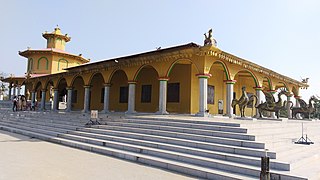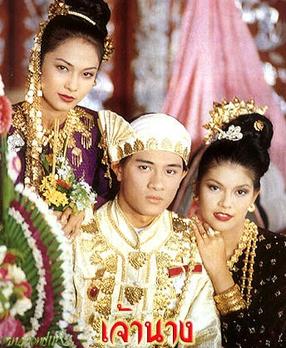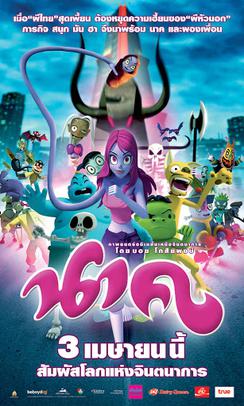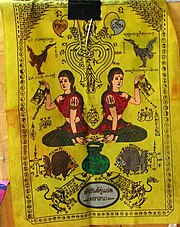
In folklore, a ghost is the soul or spirit of a dead person or non-human animal that is believed by some people to be able to appear to the living. In ghostlore, descriptions of ghosts vary widely, from an invisible presence to translucent or barely visible wispy shapes to realistic, lifelike forms. The deliberate attempt to contact the spirit of a deceased person is known as necromancy, or in spiritism as a séance. Other terms associated with it are apparition, haunt, haint, phantom, poltergeist, shade, specter, spirit, spook, wraith, demon, and ghoul.

The Rocket Festival is a merit-making ceremony traditionally practiced by ethnic Lao people at the beginning of the wet season in various villages and municipalities in Northeastern Thailand and Laos. The festivities typically include music and dance performances, competitive processions of floats, dancers, and musicians on the second day, and the competitive firing of homemade rockets on the third day. Local participants and sponsors take advantage of the occasion to enhance their social prestige, as is customary at traditional Buddhist folk festivals throughout Southeast Asia.

Yakshinis or Yakshis are a class of female nature spirits in Hindu, Buddhist, and Jain religious mythologies that are different from Devas and Asuras and Gandharvas or Apsaras. Yakshinis and their male counterparts, the Yakshas, are one of the many paranormal beings associated with the centuries-old sacred groves of India. Yakshis are also found in the traditional legends of Northeastern Indian tribes, ancient legends of Kerala, and in the folktales of Kashmiri Muslims. Sikhism also mentions yakshas in its sacred texts.

Mae Nak Phra Khanong, or simply Mae Nak or Nang Nak, is a well-known Thai ghost. According to local folklore the story is based on events that took place during the reign of King Rama IV.

The Krasue is a nocturnal female spirit of Southeast Asian folklore. It manifests as the floating, disembodied head of a woman, usually young and beautiful, with her internal organs still attached and trailing down from the neck.

The Tai folk religion, Satsana Phi or Ban Phi is the ancient native ethnic religion of Tai people still practiced by various Tai groups. Tai folk religion was dominant among Tai people in Asia until the arrival of Buddhism. It is primarily based on worshipping deities called Phi, Khwan and Ancestors.

Jao Nang, also known as The Princess's Terror, is a period horror Lakorn which originally aired in the mid-1990s and became known among Thai viewers as the most frightening lakorn. It starred Chakkrit Amarat and Kavinna Suvannaprateep in the leading roles.

Nang Kwak is a Bodhisattva, household goddess or Spirit of Thai folklore. She is deemed to bring good fortune, prosperity and attract customers to a business. Although Nang Kwak is more a figure of popular folklore than a deity, there are Buddhist legends that seek to incorporate her into the Buddhist fold.

Phosop or Phaisop is the rice goddess of the Thai people. She is a deity more related to ancient Thai folklore than a goddess of a structured, mainstream religion. She is also known as Mae Khwan Khao.

Phi Fa is a deity or spirit in the local folklore of Thailand and Laos. It is also known as Phi Thaen. They play a prominent role in the Phra Lak Phra Lam and the stories of Khun Borom.

Phraya Anuman Rajadhon, was one of modern Thailand's most remarkable scholars. He was a self-trained linguist, anthropologist and ethnographer who became an authority on the culture of Thailand. His name was Yong Sathirakoses ; Phraya Anuman Rajadhon was his noble title. He also took his family name, Sathirakoses, as a pen name by which he is well known.
Pop is a cannibalistic spirit of Thai folklore. It manifests itself as a creature that likes to devour human viscera. Pop is related to the Phi Fa spirit.

Nang Ta-khian is a female spirit of the folklore of Thailand. It manifests itself as a woman that haunts Hopea odorata trees. These are very large trees known as Ta-khian (ตะเคียน) in Thai, hence her name.
Krahang is a male spirit of the Thai folklore. It manifests itself as a shirtless man, wearing a traditional loincloth, who flies in the night.
Phi Tai Hong is a ghost of Thai folklore. It is the vengeful and restless spirit of a person who suddenly suffered a violent or cruel death.

Nang Tani is a female spirit of the Thai folklore. According to folk tradition, this ghost appears as a young woman that haunts wild banana trees, known as in Thai language as Kluai Tani (กล้วยตานี).

Nak is a Thai animated dark fantasy horror film that was released on April 3, 2008 and aired on TV in Thai PBS Kids.

Belief in ghosts in Thai culture is both popular and enduring. In the history of Thailand, Buddhist popular beliefs intermingled with legends of spirits or ghosts of local folklore. These myths have survived and evolved, having been adapted to the modern media, such as Thai films, Thai television soap operas, and Thai comics.

In mythology and folklore, a vengeful ghost or vengeful spirit is said to be the spirit of a dead person who returns from the afterlife to seek revenge for a cruel, unnatural or unjust death. In certain cultures where funeral and burial or cremation ceremonies are important, such vengeful spirits may also be considered as unhappy ghosts of individuals who have not been given a proper funeral.
The Vessantara Festival is one of the 12 monthly Buddhist festivals celebrated yearly in Theravada Buddhist pagodas in memory of Vessantara, remembered as the penultimate life of the Buddha. It is the only previous life of the Buddha which is celebrated with such importance.






















